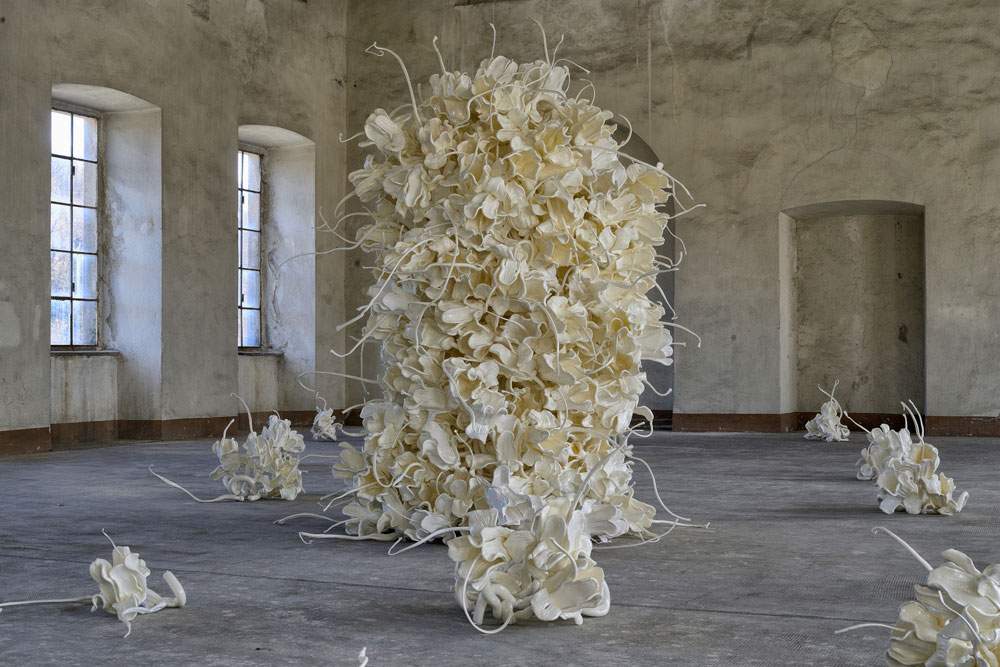Twenty years after its participation in the Venice Biennale, when Cracking Art presented 1,200 golden plastic tortoises that emerged from the sea and occupied the entire Giardini area as a reflection on the alarm of nature threatened by man, the collective is making for the first time in its history a work that does not depict animals but draws inspiration from the plant world. From June 3 to July 23, 2021 in the industrial spaces of the Tollegno 1900 textile company in Biella, the large installation entitled The Nature That Wasn’t There will be visible to the public, in close dialogue with architecture and the territory.
The work is proposed as a site-specific installation, in the large room flooded with light, composed of more than four hundred white floral elements made of plastic: a monumental work of two and a half meters in height and one and a half meters in diameter. Each flower of which the installation is composed is a unique piece, endowed with its own aesthetic and signifying potential. The material does not enter the molds but is molded by hand, transforming a quintessentially ’repetitive’ material like plastic into a moldable element, always different.
The topos of Cracking Art ’s production is the lack of seriality and is here conceived as the sign of a new man-made nature that is reborn in a different form, reclaiming its specificities and spaces, lush and vital, abandoning the homogeneity in which man tries to force it.
Nature That Wasn’t There evokes the need for reconciliation between human beings and what they themselves create, imagine and produce. In this space, the visitor is invited to identify himself to become part of the installation, reflecting on the indomitable tendency of nature, even when modified, to reorganize itself and tend toward the creation of life.
The chosen location is intended to reinforce the concepts expressed by the work: an industrial hall, but with an architecture that evokes places of worship, with the predominance of light entering from the two long sides through a series of large windows from which, looking outside, on one side one can see the mountains, the green woods, and the flowing water, while on the other the gaze is projected onto the areas of the factory still used for the production of fine wool.
Cracking Art is always based on the recovery and transformation of plastic material with the aim of investigating the relationship between nature and technology, uniqueness and serial reproduction, individuality and stereotype, to question the current and future condition of human beings with respect to the concept of sustainability. Through the use of plastic, a regenerable or regenerated material, Cracking Art creates works and installations that imagine the possible conditions of the future.
The collaboration between Cracking Art and Tollegno 1900 was born under the sign of the sharing of values related to the strong social and environmental commitment, which distinguish both realities, also united by the common Biella origin and passion for art. Within the industrial context of Tollegno 1900, which sees the company committed to an eco-sustainable approach applied to all production processes, the hybridization of the languages of art and business lays the foundations of a new cultural project that aims to bring the public closer to environmental issues through new keys of interpretation proposed by art.
Image: Cracking Art, The Nature That Wasn’t There (2021)
 |
| Biella, Cracking Art brings a large installation of 400 plastic flowers to a textile company |
Warning: the translation into English of the original Italian article was created using automatic tools. We undertake to review all articles, but we do not guarantee the total absence of inaccuracies in the translation due to the program. You can find the original by clicking on the ITA button. If you find any mistake,please contact us.